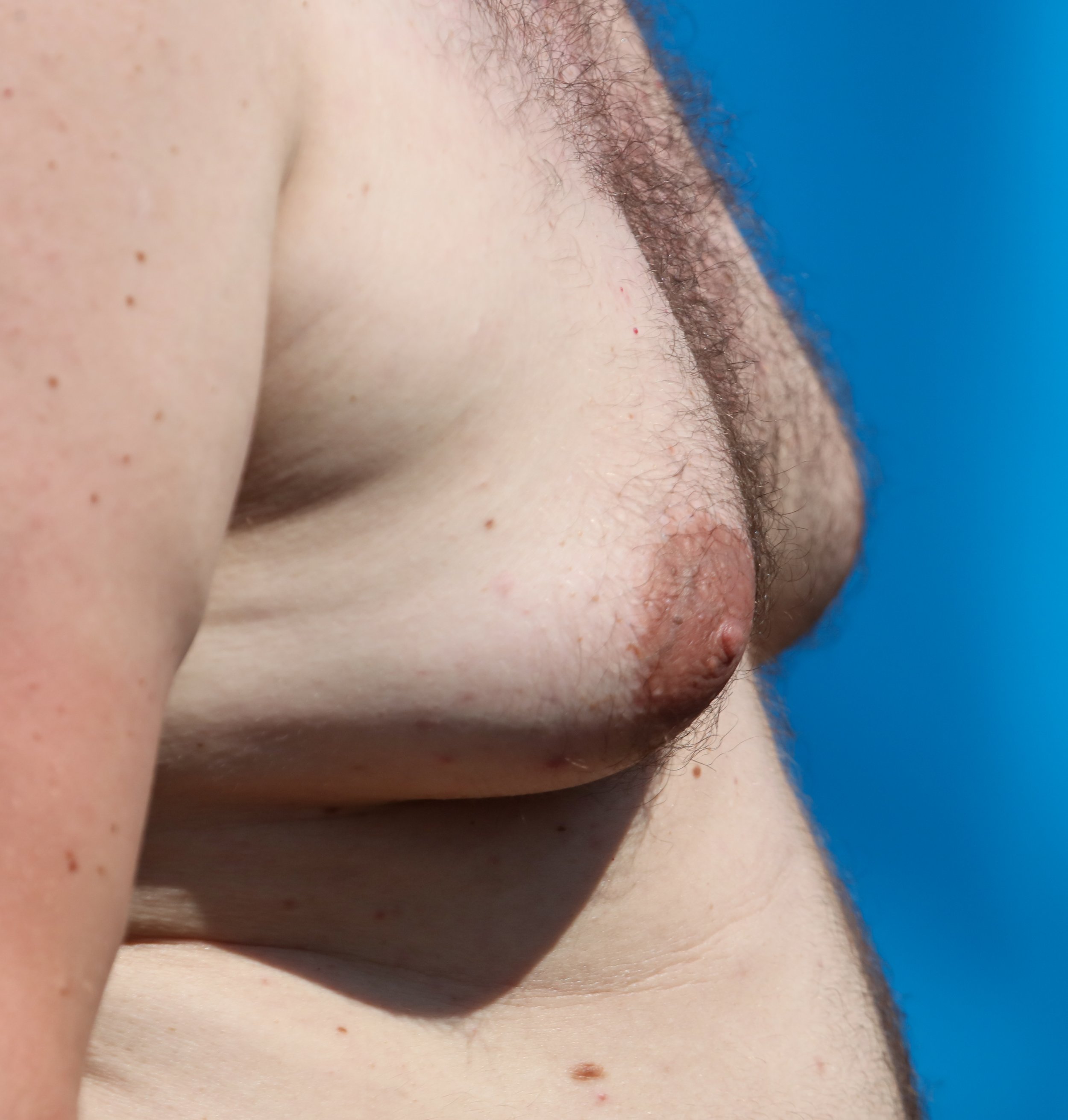
Gynecomastia Surgery
(Male Breast Reduction)
What is Gynecomastia Surgery?
Gynecomastia surgery (also known as male breast reduction surgery) reduces a man’s breast size and creates a more masculine shape to the chest. Surgery for gynecomastia correction can involve removal of tissue via liposuction alone or direct excision. In more severe cases of gynecomastia, the position and size of the areola can also be adjusted. There are many potential underlying causes of gynecomastia, including hormonal changes, genetics, obesity (pseudogynecomastia), or the use of certain drugs or medications. At Valespring Cosmetic Surgery Institute, Dr. Stephanie Dreckmann will develop a surgical plan unique to your needs and will help you improve the look of your chest. Dr. Dreckmann is a board-certified, highly talented plastic surgeon performing gynecomastia surgery in the Greater Toronto Area.
Why Get a Male Breast Reduction?
Boost self-confidence and self-esteem
Flatten and contour the chest to a more masculine look
No more worries or embarrassment about concealing your condition
Reduce breast asymmetry
Reduce areola size
Adjust nipple orientation
Enjoy better fitting clothing
Am I Candidate for Gynecomastia Surgery?
Valespring Cosmetic Surgery Institute follows all guidelines from the College of Physicians and Surgeons of Ontario to maximize patient safety, and Dr. Dreckmann will personally perform any necessary physical assessments during a consultation to evaluate your eligibility as a candidate. The following are a general set of requirements to be an eligible candidate for gynecomastia surgery:
Generally fit and healthy
Body mass index (BMI) less than 35
You can calculate your BMI here
Smokers should quit smoking at least 4 weeks prior to surgery as well as after
If your gynecomastia is related to hormonal changes during puberty, you should wait up to 2 years before seeking surgery because it may resolve on its own.
Realistic expectations
With a consultation at Valespring Cosmetic Surgery Institute, Dr. Dreckmann will help provide realistic expectations by aligning your desired chest appearance with your age, physique and proportions so that you have a clear idea of what you can expect in your final result.
Valespring reserves the right to turn down patients who do not meet the necessary physical or psychological criteria for cosmetic surgery, and would do so only because we make your health and safety our top priority.
Types of Gynecomastia Surgery
Liposuction
Advances in liposuction technology have allowed plastic surgeons to use liposuction in a growing number of gynecomastia patients, specifically those with pseudogynecomastia. It is a less invasive procedure with minimal visible scarring and allows for excess fat in the breast to be permanently removed. Small incisions are made on the side of the chest, areola or armpit to insert liposuction tools to suction out the fat.
Direct Excision (Glandular Tissue Removal)
Gynecomastia resulting from excess glandular breast tissue is usually treated at Valespring using a minimal scar excision technique. This involves creating a small incision (hidden in the edge of the areola) to remove the excess glandular tissue.
Excess Skin and Glandular Tissue Removal
Excess skin removal is most commonly recommended for patients with significant weight loss. Usually, loose and sagging skin around the chest can be removed by creating incisions around the areola, down the centre of the chest or/and in the chest crease so that large amounts of excess skin can be removed, resulting in a flatter chest with tighter skin and nipples relocated appropriately.

Let us guide you through the decision
Book a Free Gynecomastia Surgery Consultation Now!
A Gynecomastia Surgery Overview
Procedure
For less severe cases, exclusively using liposuction may be an option.
For more severe cases, excess tissue and possibly skin will need to be excised.
Gynecomastia surgery usually takes 1 to 3 hours, depending on the extent of the procedure.
Anesthesia
General anesthesia
Very minor cases may be able to be done under local anesthesia with sedation
Recovery
1-2 weeks off work
4 weeks before heavy exercise
A complimentary compression garment should be worn around the clock for 4 weeks
These numbers serve as a rough guideline, but you should always follow your surgical team’s specific and individualized recovery plan, as recommendations may vary from patient to patient
Classifications of Gynecomastia
How Much Does Gynecomastia Surgery Cost
Gynecomastia Surgery
$7000+
Cost Includes:
Gynecomastia surgery on both breasts*
Liposuction of excess fat from area surrounding breasts +/- direct excision of glandular tissue
Compression garment
*OHIP may cover surgical costs related to gland removal for very select cases but does not cover the cost of liposuction. Valespring does not provide OHIP-covered gynecomastia surgery at our facility.
Optional Overnight Stay
$4000
Patients normally return home on the same day of the procedure, but some would like the extra peace of mind of staying in an overnight bed in our medical facility, under the supervision of 2 personal attendants.
Cost Includes:
Overnight stay in one of our beds
Nurse supervision for the length of your stay
Meals for dinner and breakfast the following morning
Consultations are free with no obligation
If you have any questions about our pricing or have specific needs, do not hesitate to contact us
Prices serve as a guideline only. Fees will be adjusted based on each patient’s individual anatomy and the complexity of the case.
Prices do not include HST

Get your male breast reduction now, make payments later!
See Our Related Procedures
Liposuction
Tummy Tuck
Plastic Surgery For Men
FAQs about Gynecomastia Surgery
-
If you notice a more feminine appearance to your male chest, you may have gynecomastia. If you feel self-conscious without a shirt on due to the appearance of your chest, you may have gynecomastia. If you are unsure, you can book a free consultation with Dr. Dreckmann, our board-certified plastic surgeon, who can examine for the presence of gynecomastia and if present, can also suggest possible treatment options.
-
Gynecomastia typically resolves itself within 2 years for adolescent males, with the majority of men having gynecomastia naturally resolve by age 20. Beyond that, gynecomastia surgery may be recommended to reduce the size of the breasts.
Certain prescription drugs can contribute to gynecomastia and if an alternative medication can be taken (under the direction of a physician), it may help improve a patient’s gynecomastia. Alcohol, marijuana and anabolic steroids have also been linked to gynecomastia, and decreasing their use may also be effective in reducing gynecomastia. Rarely, gynecomastia is secondary to an underlying disease, such as a testicular tumor. It is important to seek medical attention if you notice any changes in your body.
-
The majority of cases of gynecomastia in adolescent males resolve by age 20. Beyond that, gynecomastia is unlikely to resolve without surgical assistance. If your gynecomastia is related to a particular prescription drug, changing that medication (under the direction of a physician) may improve your gynecomastia. Similarly, reducing alcohol, marijuana and anabolic steroid use may also help gynecomastia to resolve.
-
Medications and drugs that have known possible links to gynecomastia include:
marijuana
anabolic steroids and other hormones
alcohol
opioids
amphetamines
select antipsychotics and antidepressants
select cardiac and blood pressure medications
omeprazole and gastric ulcer medications
chemotherapy
select HIV medications
It is paramount that you do not alter your prescription medications if you believe they are contributing to your gynecomastia, unless directed to do so by a physician.
-
There are certain situations in which OHIP does cover gynecomastia surgery.
Adolescent gynecomastia which has been sustained for 2 years as the result of hormonal imbalance may be covered by OHIP.
Gynecomastia secondary to endocrine disease, genetic disorders or chemotherapy may be covered by OHIP.
Pseudogynecomastia as a result of massive weight gain / loss is not covered by OHIP. Liposuction is not covered by OHIP.
-
Gynecomastia is most often related to hormonal imbalances. This can happen naturally as males age. Medical conditions such as thyroid, kidney, and liver disease can also potentially cause gynecomastia as well as testicular tumors which impact hormone circulation. Certain medications or drugs can cause gynecomastia as well.
-
Gynecomastia refers to an excess of glandular male breast tissue, while pseudogynecomastia (or lipomastia) refers to an excess of fat in the chest region. Gynecomastia may be the result of a hormonal imbalance, and can often be detected by feeling for a firmness under the nipple or areola. Glandular tissue is firmer than fat. Pseudogynecomastia is typically a consequence of obesity or excessive weight gain. The breast tissue will be softer, and may have a more saggy appearance than true gynecomastia. If you are unsure if you have gynecomastia or pseudogynecomastia, you can book a free consultation with Dr. Dreckmann, our board-certified plastic surgeon, who can examine you and also suggest possible treatment options.
-
It depends on the underlying cause. The majority of cases of gynecomastia in adolescent males resolve by age 20. Beyond that, gynecomastia is unlikely to go away without surgical assistance. If your gynecomastia is related to a particular prescription drug, changing that medication (under the direction of a physician) may improve your gynecomastia. Similarly, reducing alcohol, marijuana and anabolic steroid use may also improve your gynecomastia.
-
Gynecomastia is generally not a serious physical health issue. Some men may experience some pain in their breasts. Other men may feel embarrassed about their appearance. Gynecomastia can be indicative of a hormonal imbalance and it is worth consulting your physician about options. In rare cases, it can be due to a serious underlying medical condition.
-
Gynecomastia is performed under general anesthesia so you won’t feel anything during the procedure. Patients generally experience moderate discomfort for 2 to 3 days after surgery, depending on the extent of the surgery. Your doctor will prescribe medication to help manage the pain. Swelling and pain will have largely subsided by the end of the first week and most patients are able to return to work and light physical activity.
-
A vast majority of patients are very pleased with their gynecomastia surgery results and think the procedure is worth it. In fact, on RealSelf, the gynecomastia procedure has a 96% “Worth It” rating at the time of writing this article.
-
All surgeries have risks, including gynecomastia correction, but the procedure is generally regarded as very safe. Any potential risks and complications will be outlined during the consultation. The procedure will be performed by our experienced, board certified plastic surgeon, Dr. Dreckmann, in a fully accredited surgical facility to promote patient safety.
-
If the initial gynecomastia cause was related to a particular medication or alcohol, marijuana or anabolic steroid use, and subsequently resolved by eliminating the use or consumption of that particular item, then it is possible for gynecomastia to return if the consumption of the offending agent is resumed.
If the initial gynecomastia cause was related to a hormone imbalance due to something like an adrenal or pituitary tumor, and that underlying issue remains untreated after gynecomastia surgery, then it is possible for gynecomastia to return.
If excessive weight is gained following gynecomastia surgery, the gynecomastia can return as pseudogynecomastia.
-
Yes! It can occur in newborns, around puberty and in the elderly due to hormonal changes. In younger patients, it often improves over time.








